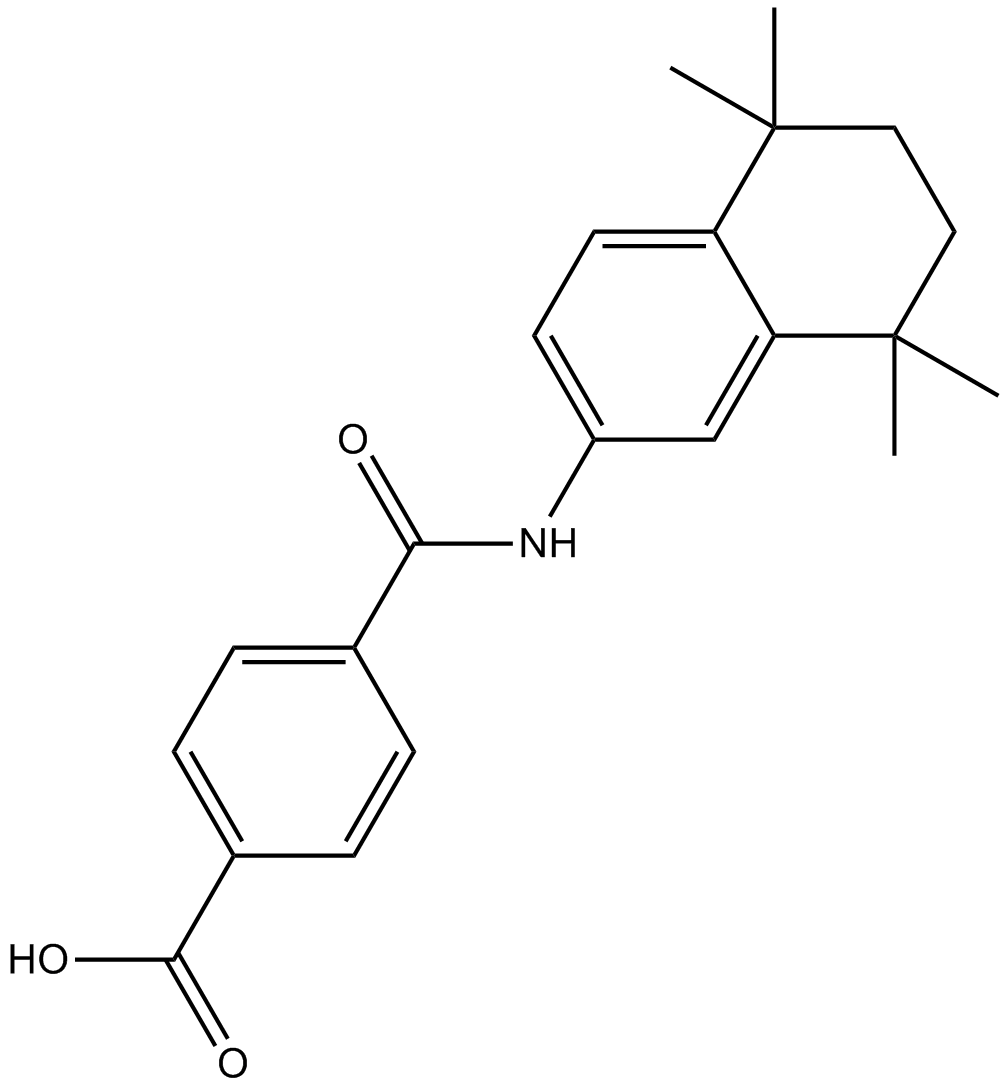Tamibarotene (Synonyms: Amnolake, NSC 608000, Retinobenzoic Acid, Tamibarotene) |
| Catalog No.GC13984 |
A selective RARα agonist
Products are for research use only. Not for human use. We do not sell to patients.

Cas No.: 94497-51-5
Sample solution is provided at 25 µL, 10mM.
Tamibarotene is a retinoic acid receptor α/β (RARα/β) agonist, showing high selectivity over RARγ.
Tamibarotene (20, 40 μM) down-regulates expression of cell cycle gene in T-cell lymphoma cells. Tamibarotene (5 μM) increases RARE activity in RARA-overexpressing cells to a much greater degree than in RARAlow cells. Moreover, RARAwt overexpression augments the degree of CDK2, CDK4, and CDK6 inhibition caused by Tamibarotene treatment[1]. Tamibarotene directly reverses the profibrotic phenotype of transforming growth factor-β1-treated dermal fibroblasts, suppresses ICAM-1 expression in endothelial cells, and promots M1 macrophage differentiation in vitro[2]. Tamibarotene (4 μM) up-regulates apelin mRNA and protein levels dose-dependently in VSMCs. Upon Tamibarotene stimulation, the RARα (retinoic acid receptor α) is recruited to the apelin promoter by interacting with KLF5 and Sp1 prebound to the TCE site of the apelin promoter to form a transcriptional activation complex, subsequently leading to the up-regulation of apelin expression in VSMCs. KLF5 and Sp1 co-operatively mediate Tamibarotene-induced apelin expression through their direct binding to the TCE on the apelin promoter[4].
Tamibarotene (1 mg/kg/day) significantly attenuates dermal and hypodermal fibrosis in bleomycin (BLM)-treated mice and tight skin 1 mice, respectively. Consistently, Tamibarotene significantly suppresses the expression of various molecules related to tissue fibrosis, including transforming growth factor-β1, connective tissue growth factor, IL-4, IL-10, IL-13, IL-17A, tumor necrosis factor-α, IFN-γ, and monocyte chemotactic protein 1 in the lesional skin of BLM-treated mice. Furthermore, Tamibarotene decreases the proportion of effector T cells, while increasing that of naive T cells among CD4+ T cells in the draining lymph nodes of BLM-treated mice[2]. Tamibarotene (2.5 mg/kg, p.o.) does not result in any significant alteration of the AST, ALT, or ALP serum levels in periodontitis-challenged mice compared with that in untreated mice. Tamibarotene ameliorates alveolar bone resorption, significantly reduces the number of P. gingivalis-induced osteoclasts in mice. Tamibarotene measurably increases the percentage of CD4+ Foxp3+ Treg cells as compared to those in EPD mice. Tamibarotene is also effective in reducing the expression of CD4+ROR-γt+ (Th17) cells in P. gingivalis-infected gingival tissues and CLNs[3]. Tamibarotene (1 mg/kg, p.o.) increases apelin expression in balloon-injured arteries of rats, consistent with the results from the cultured VSMCs[4]. In aged SAMP8 mice, hippocampal ADAM10 levels improve after Tamibarotene (1 mg/kg/day) administration. Hes5 and Ki67 are restored and spatial working memory also improves after Tamibarotene administration[5].
Reference:
[1]. Wang X, et al. Retinoic acid receptor alpha drives cell cycle progression and is associated with increased sensitivity to retinoids in T-cell lymphoma. Oncotarget. 2017 Apr 18;8(16):26245-26255.
[2]. Toyama T, et al. Tamibarotene Ameliorates Bleomycin-Induced Dermal Fibrosis by Modulating Phenotypes of Fibroblasts, Endothelial Cells, and Immune Cells. J Invest Dermatol. 2016 Feb;136(2):387-98.
[3]. Jin Y, et al. Tamibarotene modulates the local immune response in experimental periodontitis. Int Immunopharmacol. 2014 Dec;23(2):537-45.
[4]. Lv XR, et al. Synthetic retinoid Am80 up-regulates apelin expression by promoting interaction of RARα with KLF5 and Sp1 in vascular smooth muscle cells. Biochem J. 2013 Nov 15;456(1):35-46.
[5]. Kitaoka K, et al. The retinoic acid receptor agonist Am80 increases hippocampal ADAM10 in aged SAMP8 mice. Neuropharmacology. 2013 Sep;72:58-65.
Average Rating: 5 (Based on Reviews and 30 reference(s) in Google Scholar.)
GLPBIO products are for RESEARCH USE ONLY. Please make sure your review or question is research based.
Required fields are marked with *




















